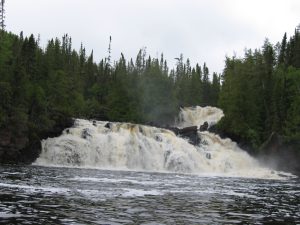
RIG A BOMB-PROOF CAMP!
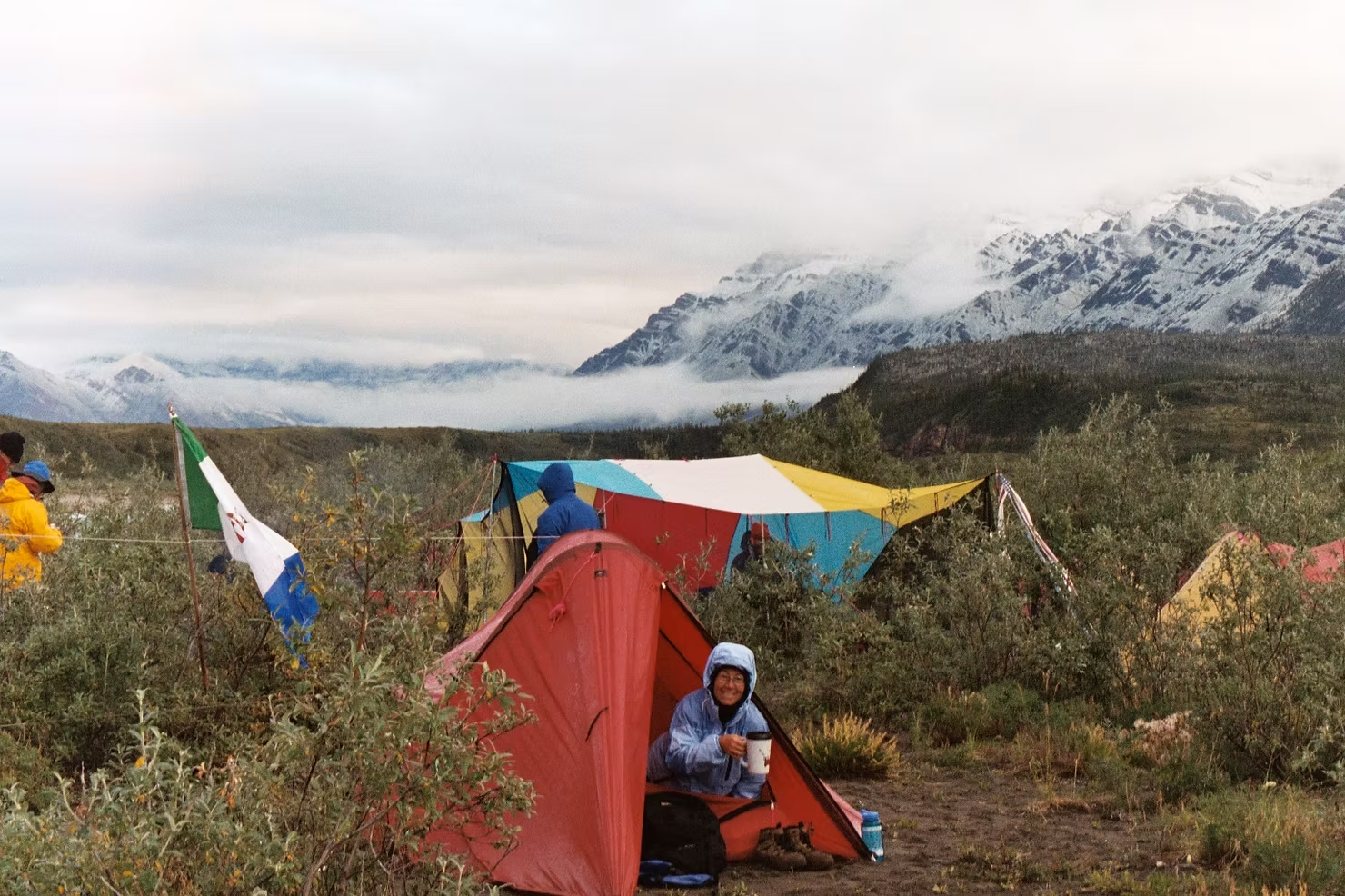
Canoe camp in the Werneke mountains, along the Snake River, Yukon, Canada
Some years ago, after a dangerous storm with winds to 50 miles an hour, a teenager and I went out to fetch water on a popular lake in the Boundary Waters Canoe Area. Everywhere, wind and rain had wreaked havoc upon the land. Clumps of uprooted vegetation floated aimlessly about, and waist-thick trees were downed and scattered all around. From our vantage point we could see three camps and there was not a tent or tarp standing in any one of them. One site revealed a thin column of smoke which suggested a barely sputtering blaze. A laughably intricate network of ropes pressured low by piles of wet clothing was a universal phenomenon.
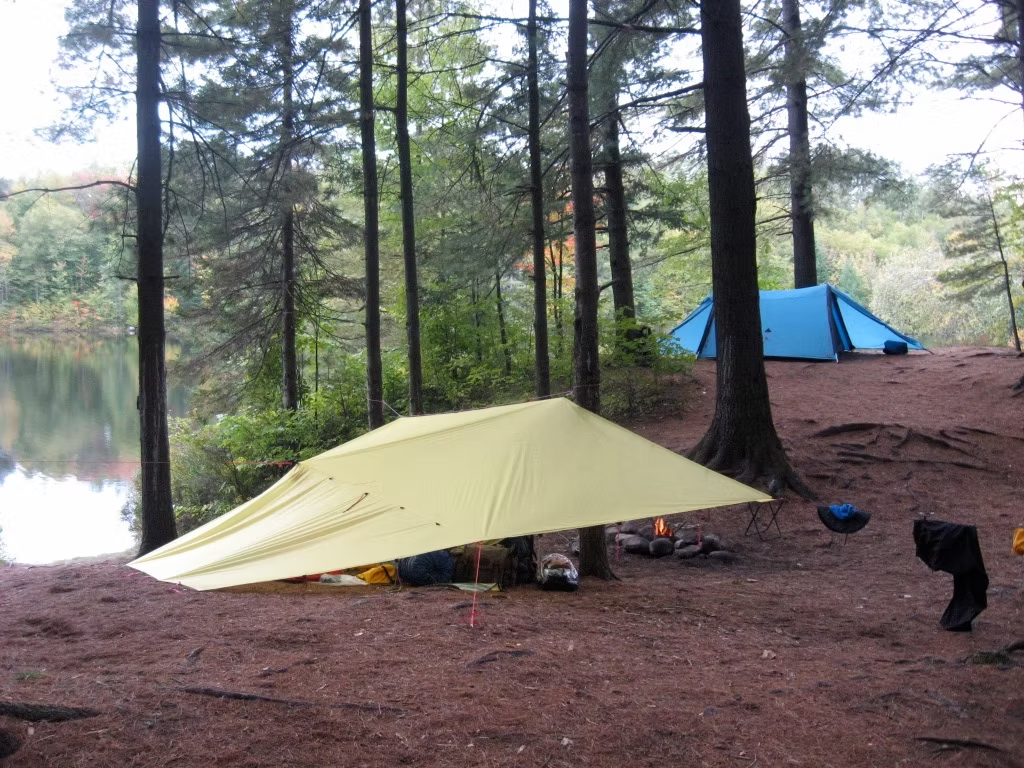
Camp in the Adirondacks Park, New York
We filled the kettles with clean, cold water then cruised on back to our campsite where five teenagers were busily tending to chores. Daintily strung from a line near the crackling fire was the only wet gear in camp – a lumberjack red wool shirt and some bathing suits and towels. Held firm by a web of brightly colored parachute cords (for good visibility in failing light), the two low slung rain tarps had weathered the storm without pooling water. Everything beneath them was sunshine dry.
I pulled the canoe ashore and set the cocoa pot on the fire, then turned to a sandy-haired girl nearby: “You guys stay dry last night?” I asked.
“Yeah, except my wool jacket which dumbo here (pointing to her freckle-faced friend) borrowed and left out all night!”
“Don’t fight, children,” I teased. “We won’t blow this place till noon. By then, everything will be dry. Now if you guys wanna see a mess, check out our neighbors around the bend.” “Yeah,” perked the boy who had joined me in the canoe – “we got us one bomb-proof camp here!”
Surprisingly, “bomb-proofing” a camp against the cruelties of nature is a function of skills not things. As the anecdote suggests, you don’t have to go far to find an inept bozo with high tech gear and no savvy. So first learn the ropes, then attend to equipment. And commit these rules to practice:
RULE 1: Read some good books on canoeing and camping before your first trip.
You can “do it wrong” for years and develop bad habits which are hard to break – the reason why studying the ways of experts is so important at the start.
RULE 2: The best gear won’t keep you dry if it’s dripping wet!
Don’t waste money on sophisticated waterproof packsacks that will eventually tear and leak. Here’s how to waterproof any pack from the inside out:
You’ll need two extra-large 4-6 mil waterproof plastic bags to serve as pack liners. The bags should be slightly wider than the pack and half as long. The inner bag is the “abrasion liner” – its sole purpose is to protect the outer plastic liner (the waterproof layer) from being damaged when stuffing your gear. Yes, this bag will eventually get small tears from stuffing. No biggie; that’s why God invented duct tape! The outer bag (waterproof layer) won’t be damaged.
You’ll find giant (36″ x 60″) six-mil plastic bags at most industrial supply centers, and at equipment shops. Trash-compactor bags also work well if they’re large enough. Or, for greater security, substitute a heavy-duty, puncture-resistant, Piragis Pack Liner/V2 dry bag for the outer plastic bag. These huge V2 dry bags have a watertight “roll down” closure and will fit the largest tripping pack.
Packing procedure: place the V2 dry bag or one plastic bag into the pack first (the waterproof layer), then nest a second plastic bag inside it (abrasion layer). Note that the outer, puncture-prone plastic bag (or V2 bag) is protectively sandwiched between the heavy cloth of the pack and the inner plastic abrasion liner.
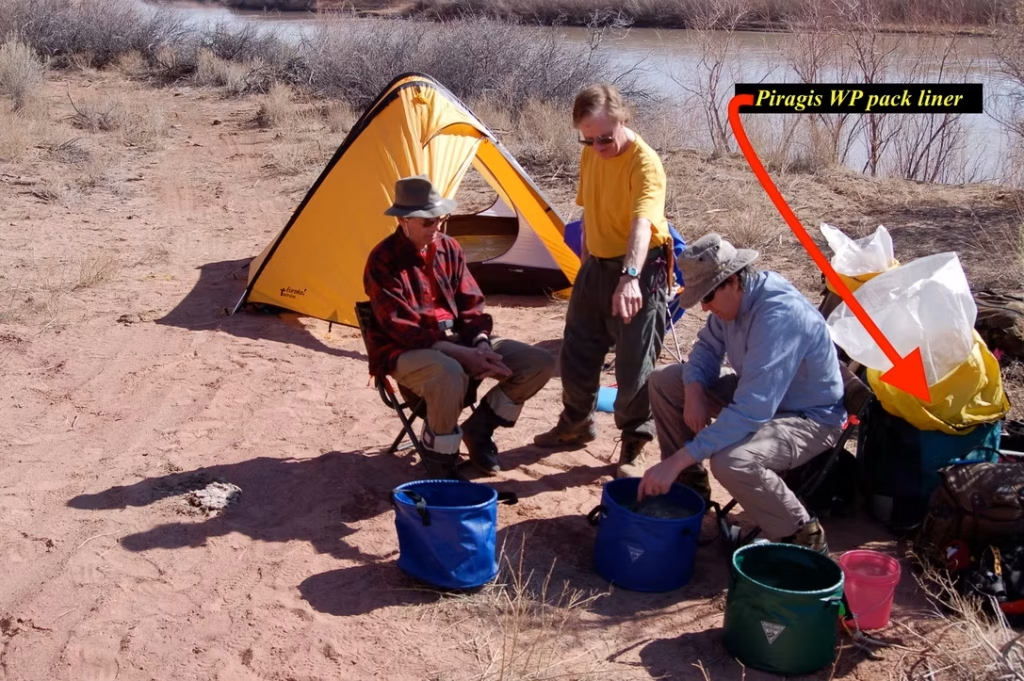
Desert campsite along the Green River, Utah
Use this “twin bag sandwich method” to pack everything you want to keep dry. For example, here’s how to waterproof your sleeping bag:
a) Put the sleeping bag into a stuff sack which need not be waterproof.
b) Nest the stuff sack inside a waterproof plastic bag.
c) Hug the plastic bag to exhaust air, then twist, fold over and seal it with a loop of shock cord.
d) Place the sealed unit inside a second, slightly larger stuff sack, which need not be waterproof.
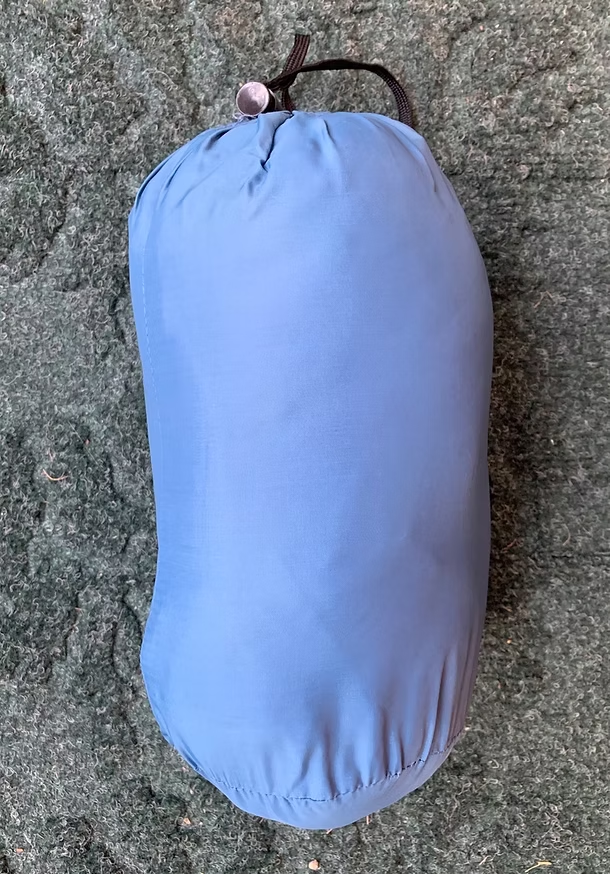
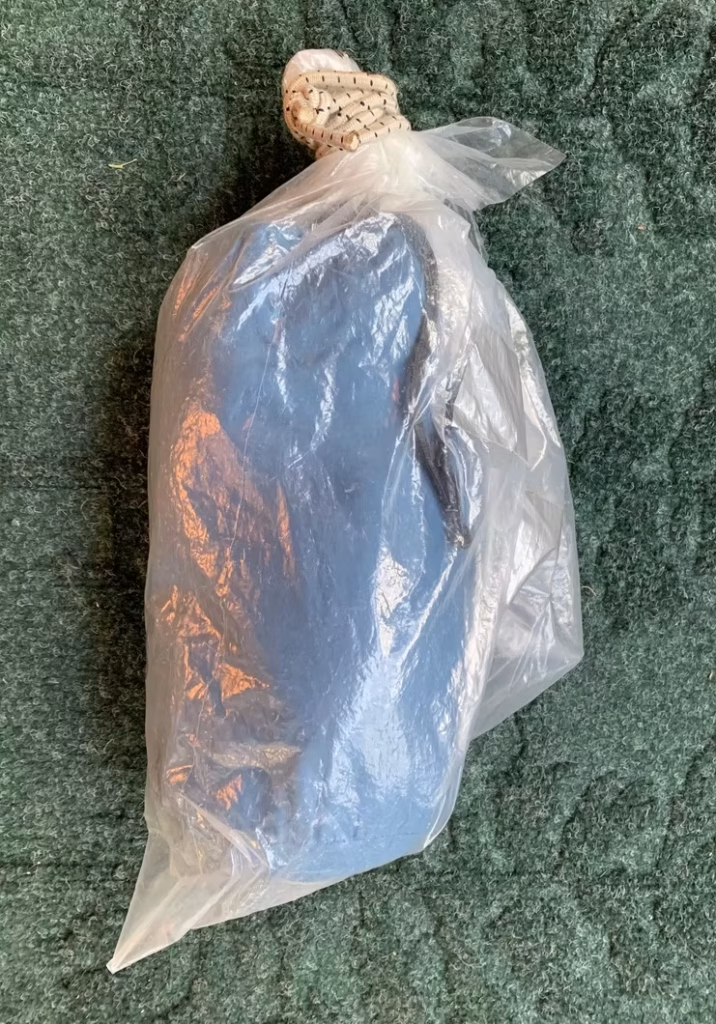
1. Stuff sleeping bag into nylon sack 2. Insert #1 into plastic bag. Seal bag.
2. (Below): Insert #2 into #3
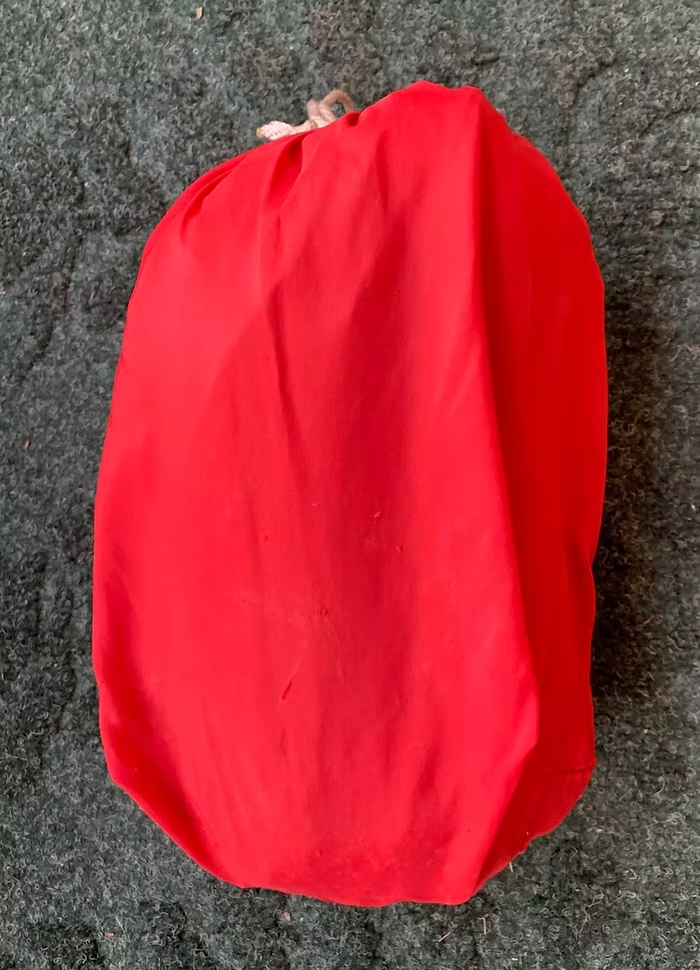
RULE 3: Always use a waterproof groundcloth inside your tent!
The best rain tent won’t keep you dry if it’s pitched in a low spot – a situation that’s often beyond your control with todays “designated” camp sites. Cut a piece of four-mil plastic sheeting a foot larger all around than the tent floor (so it will “flow up the canopy sidewalls”) and place it inside your tent. The groundsheet will prevent water which enters your tent through faulty seams and worn floor fabric from wetting your sleeping gear. Never place the ground-cloth beneath the tent floor as advised by some tent makers! Flowing ground water will become trapped between the exterior plastic sheet and nylon floor and be pressure wicked by body weight into the sleeping compartment. You’ll really have a sponge party if this happens! You wouldn’t dream of pitching your tent on a concrete slab that can pool water in heavy rain, so don’t erect it over non-porous plastic that will do the same.
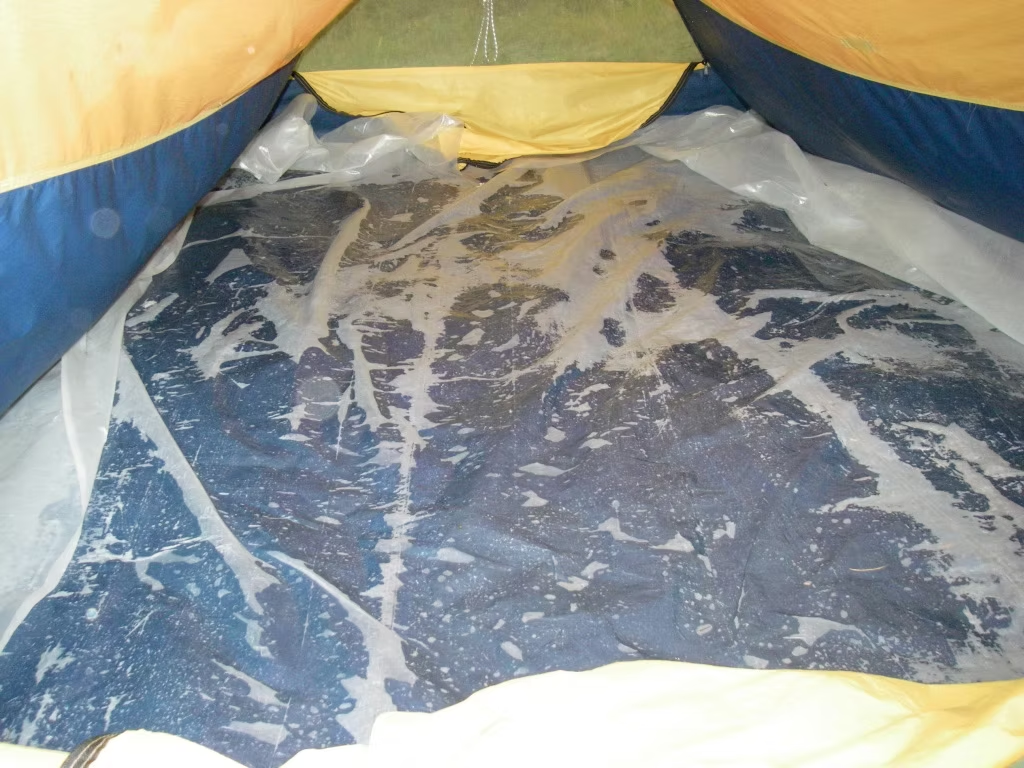
The plastic groundsheet INSIDE this tent has kept the floor dry even though the tent is flooded.
Cliff’s promise: use a plastic groundsheet inside your tent and you won’t get wet no matter how hard it rains!
RULE 4: The customary 8-10 factory stake points may not be enough to keep your tent from collapsing in high winds.
The solution is to sew nylon “storm loops” to critical places like the center sidewall and hem. The more stake points you have along the perimeter, the tighter your tent will stay in a storm. Most tents have only three or four stakes per side. Five is better. A few minutes of sewing will correct the situation.
Wherever possible, attach storm lines to the metal framework of the tent, not the nylon fly. It’s best to locate storm loops where they can be Velcroed™ to nearby poles, as illustrated below. This procedure transfers all the wind stress to the metal frame.
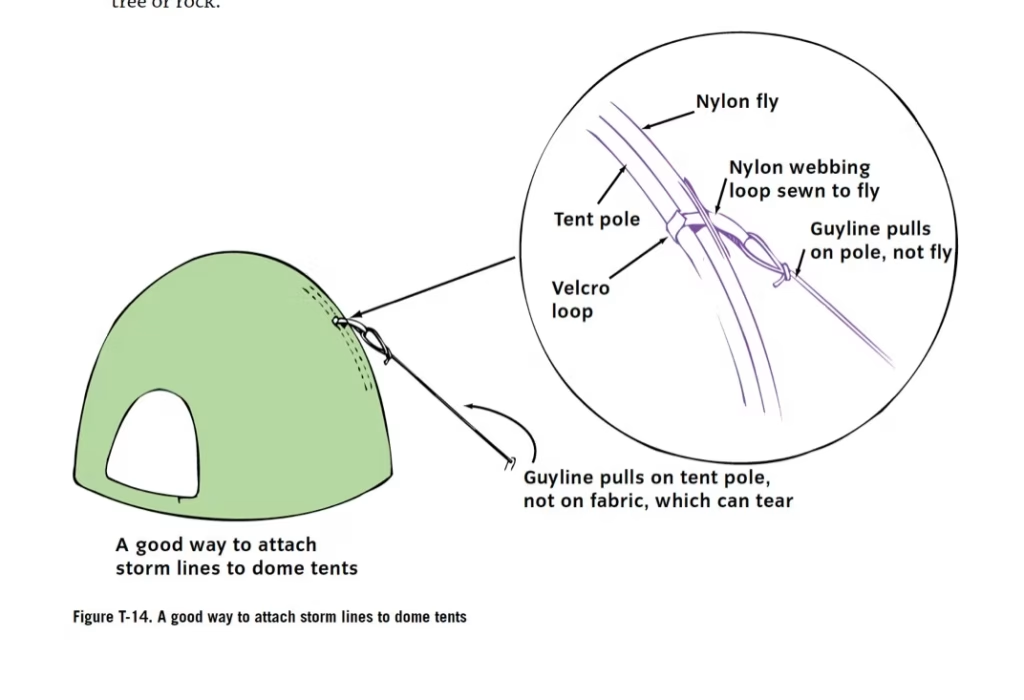
You’ll find many more tips like this in my book, CAMPING’S TOP SECRETS, 2022 Revision.
RULE 5: Double stake your tent on rock, mud or sand. Two stakes per loop – each through a separate hole, and at a different angle – doubles the surface area and holding power. On sand or rock, try the method illustrated.
RULE 6: Don’t leave home without a generously sized nylon rain tarp.
A 10-foot by 12-foot (or larger) nylon tarp, with enough cord and stakes to rig it, will provide a dry place to cook and make repairs. The alternative to a tarp is to doghouse it in your tent until the storm lifts.
Ideally, you should have one 10 x 12-foot rain-tarp for every four people. Larger crews require two tarps or one giant one. Rig two tarps lean-to style (open front, back staked down) and “float” another one overhead to provide a horizontal awning. If you leave an air space between the overlapped portions of the two tarps, smoke from a back-logged fire will be drawn out through the hole rather than into the shelter.
My video, THE FORGOTTEN SKILLS details the set-up shown below.

Note how the smoke from the campfire exits through the open slit between the two tarps.
In my view, Cooke Custom Sewing makes the best rain tarps. For large groups and buggy days, the CCS Tundra tarp, designed by Dan Cooke and I, is the most comfortable way to go.
Tip: for greater versatility, sew five evenly-spaced storm-loops to the outside face of your tarp. To stabilize a center pole in high winds, sew “butterfly loops” to the inside tarp, as illustrated on page 156, of my book, CANOEING WILD RIVERS, 5th Edition.
RULE 7: A hand-axe and saw are essential for making fire when the woods are soaked from a week-long rain.
If you’re where dead, downed wood is everywhere, you can probably get by without an axe. But it’s a must if you camp along frequented routes where all the good wood has been picked over and fire-making means splitting a chunk of log to get at the dry heartwood inside.
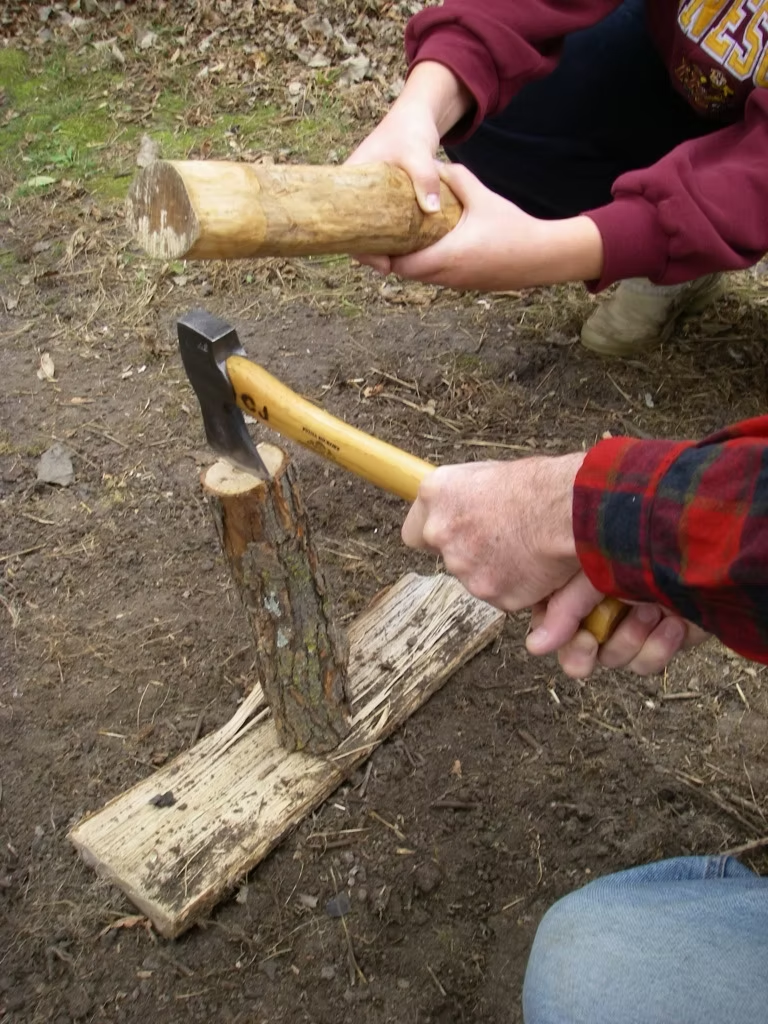
Splitting wood with a hand-axe. This procedure is MUCH safer than chopping!
RULE 8: A dry place to sit, out of the weather, adds elegance to a rainy-day camp. Under the protective tarp, you prepare hot supper for your crew, while all around the rain falls in sheets and the wind howls bloody murder. But seated high on your folding chair, you’re dry, comfortable and in command!
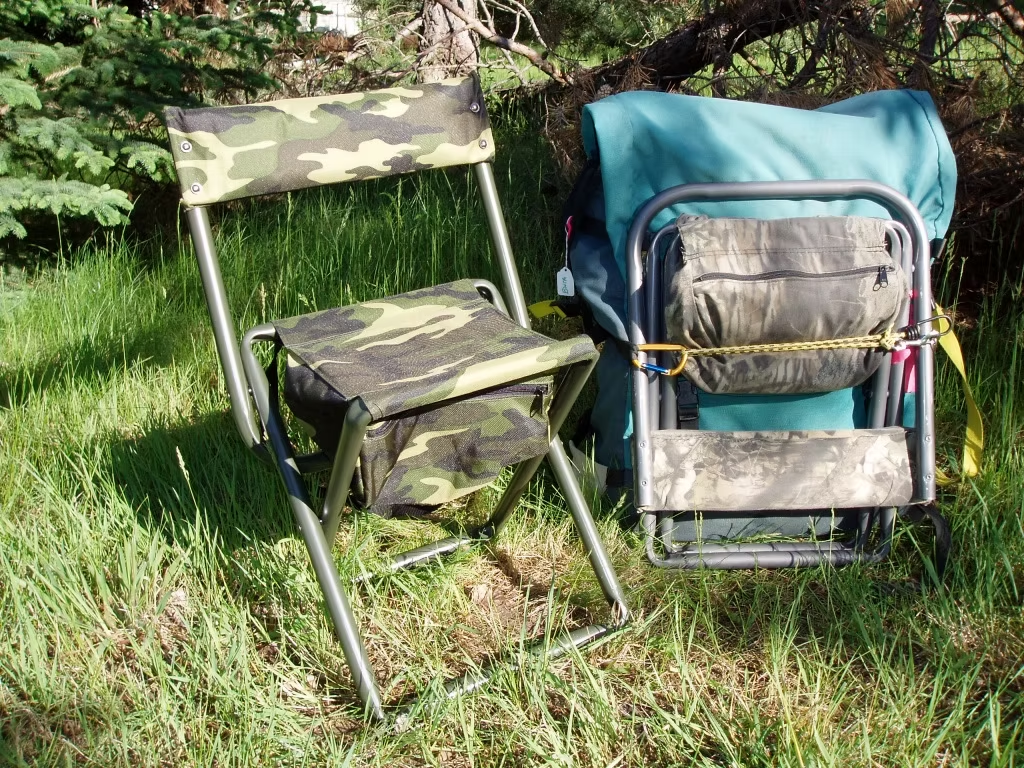
Folding chair from Piragis, Northwoods Co., Ely, MN. This model has tubular aluminum legs that won’t sink into the ground.
It folds flat and can be tethered to a pack.
——————————————————————-
*My flagship book, CANOEING WILD RIVERS, 5th Edition, contains a wealth of advice on how to safely canoe difficult rivers.
My book CAMPING’S TOP SECRETS, 5th Edition, details practical camping tips and procedures that only the experts know. If you know just a few of these tricks you’ll be a hero to your friends!
My teen book, JUSTIN CODY’S RACE TO SURVIVAL! mixes a fictional wilderness survival tale with practical outdoor tips everyone should know–a first for books of this type. Adults love it too! Now available as an audio book!
My 90-minute video, THE FORGOTTEN SKILLS details the most important camping skills. If you can do them all you’ll be a hero to your friends!
